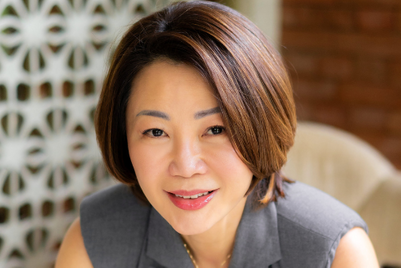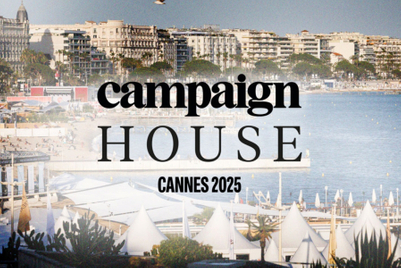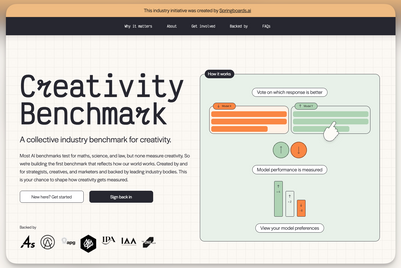.png&h=570&w=855&q=100&v=20250320&c=1)
Creativity at this year’s Cannes Lions was a study in contrasts. AI was everywhere the eye could see… at the centre of the tent, in panels, in yacht briefings, in conversations. However, the relentless proliferation of tech didn’t find its way into the work that won the shiny metals. For that, the spotlight remained firmly on concepts that are profoundly human, rooted in emotion, clarity and craft.
Film, in particular, reflected this tension. On one side, short-form content is taking over marketing budgets, with TikTok, Instagram, and YouTube Shorts driving how brands connect with audiences. But inside the jury room, the winners told a different story. The campaigns that truly stood out were overwhelmingly long-form—narratives that took their time to breathe, connect, and resonate. Short-form, by comparison, struggled to leave a mark.
Valerie Madon, the APAC chief creative officer for McCann Worldgroup, also a Film Lions juror, said in an interview at Cannes with Campaign Asia-Pacific, “We hunted for standout short-form work, but only a handful delivered. Among those, Telstra’s ‘Better on a Better Network’ stood out as a rare example of how to use the standard 30-second canvas to great effect.”

30 seconds is the standard length of a TV or online ad, the bread and butter of the industry. It’s a format that demands focus.
“Short-form is a fantastic canvas for creativity, but it requires skill, craft, focus, and discipline to excel. Telstra’s campaign delivered a clear, compelling message with precision to earn a Gold Lion,” said Madon. But even with its sharp execution, Telstra’s ad fell short of the emotional depth and visceral impact needed to claim the coveted Grand Prix, the festival’s highest honour. Grand Prix winners, like Channel 4’s ‘Considering What?’ and L’Oréal Paris’ 17-minute documentary ‘The Final Copy of Ilon Specht', showed the power of long-form storytelling to leave a lasting impression.
“These films were felt in the heart, the gut, and the mind,” said Kate Stanners, Film jury chair and global chief creative officer at Saatchi & Saatchi. For Stanners, the magic of Film lies in its ability to connect with audiences on every level. “Film talks to you. When it’s done well, it makes you think, feel, or do something you didn’t expect.”
Film remains the festival’s oldest and largest category in terms of volume, with 1,636 entries and 115 shortlists this year. Yet the dearth of truly exceptional short-form work felt like a missed opportunity. “Short-form content is everywhere in our feeds, but it didn’t dominate here [at the Lions], because it’s not enough to just be brief,” Madon quips. “You have to use the format to tell a bold, emotionally charged story. That’s what’s missing right now.”
Stanners agreed, pointing out the delicate balance film requires. “It’s so difficult because film is the marriage of craft and idea to make you feel something and move you,” she said. “It’s not just about execution—it’s about creating something that stays with you long after you’ve seen it.”
Done right, humour is more than a punchline
Humour made a comeback at this year’s Cannes Lions, and it wasn’t subtle. While Cannes Lions still has to officially crunch the submission numbers around this, the spike in the 2024 entries when Lions introduced the Humour subcategory, was unmistakable. “In this category, the work ahs to entertain to win. That’s the entry point. If it’s not entertaining, don’t even enter. Almost 80% of the work that won in Film, had some style of humour,” said Madon.
Take KFC Thailand’s ‘Let There Be Cake’, which swiped a Gold for its quirky, culture-savvy approach. Or the unexpected laugh in L’Oréal Paris’ Ilon Specht, where at one point, Specht stares down the interviewer and blurts blunty, “F*** you.” When he asks, “Why f*** me?” she retorts, “Because you’re a man.” “It’s humour that’s sharp, layered and purposeful. Humour has come a long way from the slapstick commercials of the past.”
The resurgence of funny is a welcome respite, especially when you consider how brands had left it on the fringes. According to a report by Kantar, advertisers spent the past two decades leaning into serious tones, forgetting humour on the way. But in November 2023, Cannes introduced a dedicated Humour sub-category, and suddenly, the industry remembered how powerful a well-crafted joke can be.
But did Cannes spark this shift, or was it simply mirroring the changes in society?
Madon believes it’s a bit of both. “Humour has always been ingrained in APAC advertising,” she said, pointing to Thailand, the Philippines, Japan, and India as examples. “These markets have long understood that humour makes people remember, relate and buy.” Perhaps, Cannes stamp of approval signaled to brands what creatives always knew: humour is one of the sharpest tools to make a complicated point succinctly.
The data agrees. Kantar found that humorous ads are 27% more expressive, 14% more involving, and 11% more distinct.
“The industry is using it as a creative strategy, not just a device to entertain.” She pointed to ‘The Last Birthday’, a Lion winning campaign for Association Valentin Haüy by Josiane Paris that used humour in a dark, psycho-thriller way. “It was deeply disturbing but also incredibly clever. Humour doesn’t have to be light-hearted, it can be sharp, unsettling, and play on different narrative styles to be highly effective.”
Yet, not everything hit the mark. Madon lamented the absence of Japanese humour, which has often brought surreal, culturally distinct comedy to the global stage. “That’s something I want to tell Japan,” she said. “‘Hey, bring back the Japanese humour… the world missed you.”
Challenges of scale and the evolution of purpose
APAC celebrated a 27% spike in wins this year, taking home 118 Lions. But when you step back and view the region’s performance on the global stage, the cracks show. While APAC’s creativity is undeniable, many campaigns struggle to scale beyond their local markets.
“A lot of Asian campaigns are brilliant in their own markets but don’t scale well,” said Madon. “But scalability isn’t just about going global—it’s about showing how a local insight can resonate universally.”
Case in point, Ogilvy Singapore’s ‘Vaseline Verify’ campaign, which won in a raft of categories, including a Grand Prix in Health and Wellness, as an example of getting it right. “That campaign had scale. It took something specific and made it relevant across markets. It’s not just about solving a local issue, but it aligns perfectly with the brand’s global goals. That’s what made it work.”
The challenge feels sharper when you compare the region’s performance to other markets like Brazil. That single market has taken home 99 Lions this year, outpacing all of APAC countries. Only India (32 Lions) and Australia (27 Lions) made it into the global top 10.
In a previous interview with Campaign Asia-Pacific, Titanium jury president, Judy John said it’s also about presentation and a lack of brave CMOs. “In regions like the US, there’s heavy investment in crafting case studies,” said John, global CCO at Edelman. “The level of polish and money put into them is incredibly high. APAC has brilliant ideas, but the way the work is presented doesn’t always match up. And some CMOs in the region aren’t as brave as their Western counterparts who are more willing to take risks and prove themselves. I'd love to see braver decision-making CMOs and CCOs (chief communications officers) in APAC, because the creativity and talent are absolutely there.”
To John’s point, culture plays a central role in shaping creativity, and in APAC, that influence is impossible to ignore. Singapore, the region’s unofficial official creative hub, is a nation driven by left-brain professions—lawyers, bankers, coders. Here, creativity often feels like an afterthought, a luxury rather than a necessity. The late Lee Kuan Yew, Singapore’s founding father, famously said, “Poetry is a luxury we cannot afford.” And that no-nonsense pragmatism still looms over our mindset.
Evolution of purpose is another trend that has been universally observed. Of the 34 Grand Prix awarded this year, 22 had a purpose-related theme. And this wasn’t saving the planet or planting trees or pulling heartstrings with award-baity work kind of purpose. But work that’s fine marriage between purpose, business and societal impact.
“Purpose felt different this year,” said Madon. “It’s not what a brand claims to stand for, but how it acts every day. And that’s tied to business. If it’s not driving commerce, it’s not working, and it’s not winning.”
Famously, “If it doesn’t sell, it isn’t creative.” Van Gogh might have thrown a sunflower at that logic, but in adland, Ogilvy wins... and that’s the gospel Madon is bringing back to her team.


.jpg&h=334&w=500&q=100&v=20250320&c=1)



.png&h=334&w=500&q=100&v=20250320&c=1)



.png&h=334&w=500&q=100&v=20250320&c=1)








